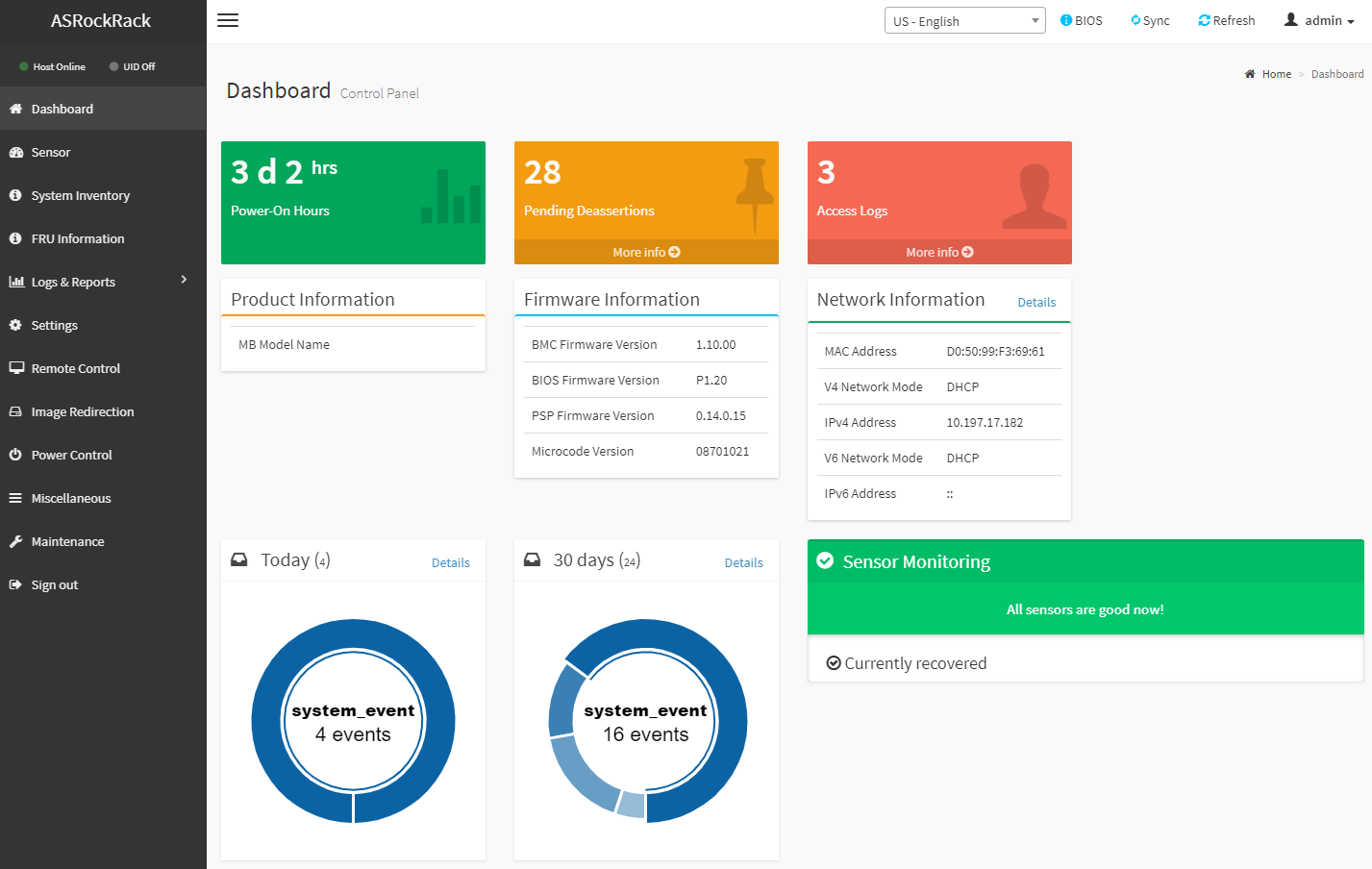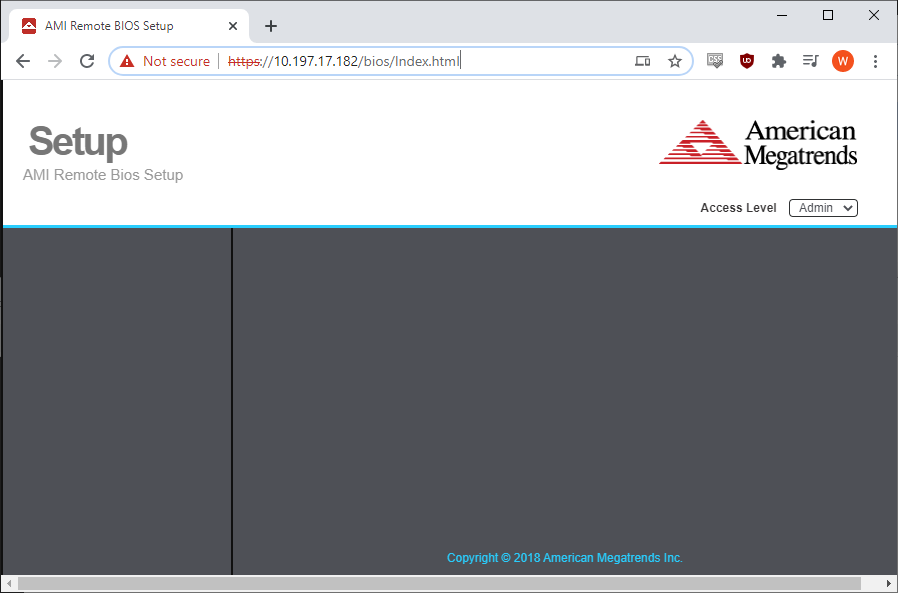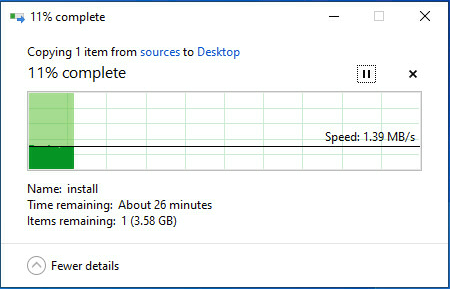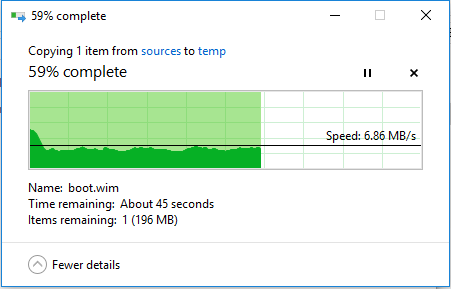ASRock Rack X570D4U-2L2T Management
The out-of-band management is the standout feature of this motherboard and is handled by the ASPEED AST2500. Full KVM support is included out of the box, along with the ability to perform BIOS and BMC upgrades from within the web GUI.

The KVM is available via HTML5 or Java, and one small perk over the Supermicro HTML5 client is the ability to easily mount CD/DVD ISO media directly from the HTML5 KVM client. Since the inclusion of the BMC is the defining feature of this motherboard, executing this feature well is a must and the solution on the X570D4U-2L2T mostly works well and does not require any additional licensing for full functionality.
New to the X570 boards over the X470 predecessors is the ability to access the BIOS settings themselves via the BMC. On the X570D4I-2T this functionality was partially broken, presenting only a subset of the options available in the full preboot BIOS and never updating the system inventory; on the X570D4U-2L2T the remote BIOS is completely broken, and simply fails to load any functional user interface.
This remote BIOS may be web implementation atop a Redfish API, but I was unable to verify anything other than the non-functionality of the web UI. Redfish is not mentioned in any of ASRock Rack’s documentation nor specifications, and so this feature remains entirely undocumented.

Additionally, the BMC exhibited the same slow transfer speeds for mounted media that previous ASRock Rack series boards demonstrated on both the HTML5 and Java iKVM clients. Despite the BMC itself being linked to the network at 1GbE rates, transfer speeds were still very slow. This behavior was identical to the X570D4I-2T, and the BMC remote media seemed artificially limited to 1.39 MB/s.

As a sanity check, I performed the same test on an older Supermicro X10SRL-F board which ran at above 6 MB/s, so even in the context of other ASPEED BMC implementations, the ASRock Rack remote media is slow.

ASRock Rack has again adjusted the default number of remote media instances; this time, set to zero by default. This does mean that users will have to adjust this setting in the BMC UI to enable remote media support, since without any remote media instances enabled the options to mount a virtual ISO are missing.
Overall, this is a fairly standard MegaRAC SP-X management solution. Having the ability to utilize remote iKVM on the platform as well as perform tasks such as remote power cycling and use management tools is a key feature of this platform.
ASRock Rack X570D4U-2L2T Test Configuration
Here is the basic test configuration we used:
- System: ASRock Rack X570D4U-2L2T
- CPU: AMD Ryzen 5 3600, 3950X
- Memory: 2x Crucial 16GB ECC UDIMMs
- OS SSD: Samsung 970 EVO Plus 250GB
In the future, the AMD Ryzen 5000 series may become a more popular option, but giving pricing and availability, it seems as though the Ryzen 3000 series is going to be more popular in the short-term.
ASRock Rack X570D4U-2L2T Server OS Testing
Like the previous ASRock Rack Ryzen-based server boards X470D4U before it, the X570D4U-2L2T has a very small list of officially supported operating systems; this list consists of Windows 10, Ubuntu 18.04, and RHEL 8.1. This list is at least includes newer versions of Ubuntu and RHEL than the previous motherboards. Just as before, we undertook the task of testing various other operating systems that are not on this list. This testing is not comprehensive; operating systems were installed and tested for basic functionality but not much more. Potential purchasers would want to verify their particular OS and applications work on this platform before investing in the widespread deployment of this solution. With that said, we were able to install and operate the following list of operating systems without issue:
- Windows 10 x64 2004
- Windows Server 2019
- Ubuntu 20.04.4
- CentOS 8.1.1911
- VMware ESXi 6.7 Update 3
- FreeNAS 11.3-U2
Next, we are going to discuss performance and power consumption before getting to our final thoughts on the platform.




“One note, the shared interface for the AST2500 is on the 10 GbE NIC, not the 1 GbE NIC.”
A word of warning that if you accidentally enable IPMI access to the 10 GbE NIC (eg. selecting link aggregation in the IPMI settings), it will wreak havoc with performance on that interface.
I spent weeks trying pfSense tuning settings to figure out why performance was nowhere near 10 Gbps. It was only by accident that I noticed the IPMI setting and turned it off.
Great review and certainly a compelling alternative to something like the SM X11SCH-LN4F.
I asked Asrockrack about supporting DDR4 ECC RDIMMS, they are not supported.
Bad luck, and it is sad.
Any comment on the lack of ECC report support?
Will it still be able to correct smaller bit errors, don’t even know if ECC is capable of that?
In my +25 year in the IT business I cannot remember I have ever ran into a computer that had corrupted modules in a way where ECC would have seemed to make any difference. As fare I can remember it has always been a matter of boot errors or the computer couldn’t see the module at all. Not saying it couldn’t be the case, but I can’t remember I’ve ran into the situation myself.
@MrCal: ECC-Errors goes along with me since dekades with different vendors.
@Willy: These guys measures different Power consumption: https://www.hardwareluxx.de/index.php/artikel/hardware/mainboards/53917-asrock-rack-x570d4u-2l2t-im-test-fuer-den-home-server-bereich.html?start=5
How well your measurement device works with complicated power factor conditions?
Did you have a look at the iommu grouping of that board?
Anyone has distributor in EU that could offer combo with chassis for this baby? If they can do QA before shiiping, I’m all in.
Tnx
“One note, the shared interface for the AST2500 is on the 10 GbE NIC, not the 1 GbE NIC.”
Any particular reason why they did so ? 1 GbE was not enough for IPMI ?
domih,
I assume it was so that, under the assumption you only had a single available switch port to plug the server in with, that you could have both 10 GbE and IPMI access.
The lack of ECC error reporting is kind of unfortunate.
@Datasaver Someone posted IOMMU groupings for the X470D4U board a couple months ago, which I assume would mostly translate to the X570D4U, too: https://www.reddit.com/r/ASRock/comments/hwuotz/asrock_rack_releases_microatx_x570d4u2l2t_based/g3pp023/?utm_source=reddit&utm_medium=web2x&context=3
@Datasaver/@Will Taillac:
Both my Xeon D-15xx Boards draw more Power than servethehome has measured. I always wondered what I am doing wrong in configuring the systems, as power consumption is important for me.
My X10SDV-TP8F idles at 26W with everything stripped except for 2*32GB RAM, a single mSATA-SSD and a small FAN at low revs. I use a 300W Gold PSU. “Power off/BMC only” is 7.5W in this configuration. Servethehome has measured 22.9W/4.9W for the X10SDV-4C+-TP4F in a test configuration with double the RAM and many SSDs. If I move closer to the test configuration used for the review of the board, I am at >30W/10W.
I wonder where the difference comes from, especially since even if I assume that servethehome is measuring power with a simple configuration, at least my BMC only values are to high. One can argue that my board has an additional quad port i350 NIC, but even the X10SDV-7TP8F was measured at only 5.0W and it has my configuration +12 Cores +SAS-HBA
@cspguy: RDIMMs are not supported on Ryzen or Threadripper, you have to go to EPYC to get RDIMM support. There’s nothing ASRock Rack can do about this, it’s a limitation from AMD.
This board will do 3200M/T memory, as long as its only two sticks, according to Asrock. 4 sticks is 2933 if single rank, 2667 if dual rank (if i read their response correctly). They also confirmed that Ryzen 5000 support is coming sometime December or January.
How would this board do in a workstation? I’ve been trying to make a compact desktop for work and gaming with 10gbe, but available components are sparse. Next best solution is some finagling with a pcie extender to make room for the chunky gpu.
Hello,
Does the motherboard includes an integrated, non-removable, backplate on the socket as the X570-D4I-2T ?
Thanks !
@Elsa,
Yes. But it’s a standard AM4 backplate design, nothing Intel flavored like on the X570D4I-2T. The stock Ryzen 3600 cooler mounts just fine (wraith spire), as does the Wraith Prism.
@Patrick,
As a workstation board, this will do fine, though perhaps not better than any other X570 board. The BMC doesn’t do much for a workstation. On the other hand, it may actually be the least expensive X570 board with onboard 10 GbE networking, but you can always just get a ‘normal’ X570 board and an add-on PCIe 10 GbE NIC.
What i really hate, also on the X399D8A, is that anoying slow media speed via BMC. Why, Asrock??? It’s almost impossible to use that for a reasonable remote installation e.g. of anything larger than a MSDOS image. Installing Windows or also TrueNAS/FreeBSD is a pain.
Why the heck? My old X10SL7-F and X11SSH-CTF (both having the older AST2400) are also not fast, but much more bearable.
And also, routing the BMC via 10GB at the X11SSH-CTF does not reduce 10G speed in my case.
So, allthough i really would like to use the Ryzen Zen2 or 3 as a multipurpose home server, the Asrock Rack AMe/TR4 boards try to mimic server boards and present lots of server features, but are lacking in the end a good implementation.
– only partial ECC features (even my B550M Tuf Gaming reports ECC to the OS)
– almost impossible BMC media useage
– slow memory speeds with 4 sticks (and we all know: memory speed is important for Ryzen)
– it seems performance problems when routing BMC over the regular NICs
– only limited attention for Bios updates.
So, all in all, the plattform looks attractive at the first glance, but seems to lack enthusiasm in the details then leaving it with some quirks.
@ZFSfan
My understanding of the “ECC reporting” problem is that the OS will be aware of an ECC event, but the report does not travel ‘upstream’ to the BMC/IPMI environment, where it normally would on a normal ‘server-class’ platform. Since the BMC is where many sysadmins make their first stop when investigating a potential hardware issue, lack of memory reporting in the BMC log is a big deal.
Windows Server 2016 and 2019 dont work on this board. Warning.
@AW,
I cannot speak to Windows Server 2016 since I did not personally test it. However, I have encountered no difficulties with Windows Server 2019, as you can see here: https://www.servethehome.com/wp-content/uploads/2020/11/ASRock-Rack-X570D4U-2L2T-Windows-2019.png
Windows Server 2019 works fine, I installed it earlier today on my X570D4U-2L2T along with an AMD Ryzen 5950X using the beta BIOS.
Currently in the process of building 3 servers build around this motherboard for those interested (first completed as of today) – https://forums.servethehome.com/index.php?threads/asrock-x570d4u-2l2t-build.30697/
Just in stock at Newegg, I snatched one
Does anybody know it it allows iGPU passthrough for a 4xxx series APU?
Despite the reported slow virtual Media speed and my small “rant”: I got that board and paired it with a 5600X and 4*16GB ECC-Ram (Samsung B-Die modules).
And, I’m happy with it and can support the high rating now. I tested it with Server 2016, 2019 (no left device manager items without driver), ESXI 7.0 and Win10. Works like a charm incl. some moderate memory OC.
Windows, Memtest and FreeBSD are showing “ECC”, so the corrective function seems to work.
Also Passthrough of a SAS-HBA (9400-16i) from ESXI to a FreeBSD-VM (for ZFS) works.
To be on safe side, i gifted the X570 chipset a silent 60mm fan blowing in direction of the two M.2 sockets to bring a little airflow also to the NVME drives. Without a little airflow, i got very soon a overtemp warning from the IPMI for the X570.
All in all: nice little board to squeze out all of the PCIe lane possibilities of AM4 plattform, high clocked CPU cores, surprisingly (for X570 and non-APU processor) pretty energy efficient.
Has anyone installed ESXi latest release with SATA passthrough? it will allow to enable it but it won’t work
1609631249295.png
It stays on the Need Reboot option and won’t show it to the VM
Maybe because this board is not officially supported? I am going to have to get an HBA for it which I was trying to avoid
ZFSfan your board is running at 2933 with the 4 modules correct? could you list where you got it? thanks
What the chipset running very hot? The heatsink is kind of small. Someone did report 81 C at idle.
Could someone enlighten me if I would be running out of PCIe lanes with this build? Many thanks!
CPU: 5950x
GPU: 3060ti – PCIe 4.0 x8 (limited from x16 to x8 because of the HBA.)
HBA: LSI 2907 – PCIe 3.0 x8 to backplan
M.2 Slot 1 – Samsung 980 2tb NVME – PCIe 4.0 x4
2x 10Gbe ports – PCIe 3.0 x4
1x Gbit IPMI (I don’t think I understand how this impacts the 10Gbe controller!)
1.) …Do I have any PCIe lanes left?
2.) What are the options if I wanted to expand SSD capacity down the road?
2a.) What would happen if I put another NVME drive in the second M.2 slot?
2b.) Would my only option be to use the SATA ports for SATAIII SSDs?
3.) A 3060ti should have little to no performance loss being 4.0 x8 right? My understanding is that is essentially the same as PCIe 3.0 x16 as far as bandwidth goes.
@Kyle
Personally my worry is that chipset running hot. I saw a video of someone reviewing this board and he went through the sensor pages in the bios and noticed the X570 chipset sensor reporting 81 C !! Now I don’t know if that was a sensor glitch but it did seem very odd. I don’t know if anyone else noticed something similar?
To answer some of your questions :
1) I think you are good as long as you don’t use the second M.2 which apparently shares bandwidth with the NICs.
2) Well you have so many options there, you could buy an internal hotswap drive bay. You could purchase a large SSD and just transfer your files over.
2a) I answered that on point 1)
2b) You could buy a better LSI card with more connections.
3) I think your good but what do you want to do? Video encoding?
@Patrick
Thanks for the info!
Yes I have definitely read that about the chipset being passively cooled and getting a bit toasty. I’ll have a decent amount of airflow from case fans in a rackmount chassis but I’ll definitely add a dedicated fan for the chipset if needed.
I’ll look into a better LSI HBA option…open to recommendations as I can’t say I am very familiar with their line. That was supposed to read LSI 9207 by the way – sorry for the typo! Or maybe I just use a breakout cable on the second port of that card with SFF-8087 to SATA so I can pass through some SATA SSDs…not sure if there is a way to pass through NVME that way.
Yes the 3060Ti would be for video transcoding mostly. I know most use a P2000 for Plex hardware transcoding but it only has 5GB vram so I don’t really see the value when they cost the same except I wouldn’t have to fiddle with the patch to unlock more than two transcode processes at a time. Open to suggestions though. I don’t upgrade hardware often so I want to make it count!
@Kyle
You could try the LSI 9201-16i if you think you’ll need all of that. It would be much better than using the motherboard’s SATA that is for sure.
Hopefully you wont be getting to many issues with the chipset. IT is for that reason that I am considering the little brother X470D4U2-2T. For what I would be doing, it would be more than enough I think and would not have to worry about the chipset overheating in case a fan is defective and whatnot.
@Patrick
Thanks I’ll look into that one. Yeah I understand about the heat but I think I will roll the dice. The addition of PCIe 4.0 in the x570d4u-2l2t is enough for me to take a chance as it provides some more options with the extra bandwidth.
I have 2 NVMEs and would like to use both for an unraid server. If the 2nd NVME shares bandwidth with the nics, I will need to come up with a better plan.
For now, I am thinking maybe I can just get a SATA to NVME converter and use that as an additional drive. Thoughts?
Also, which bifurcation cable can I use with this? I will purchase one but I just needed to know which one is compatible with this.
I will be putting 4 cards in there.
1. NVidia Quadro p600
2. LSI HBA
3. A quad nic PCIe single-slot controller for dedicated ports for all the VMs I will run inside unraid
4. PCIe NVME card to get good NVME performance (this will only be used if the Sata to NVME solution above is slow
How is the stability of this board for 24/7 use?
Is it ok going o Ryzen 5800x or better going to good old 3700x?
Can be used with Esxi 7?
When installing Server 2019 I’ve found 5 unkown devices and Windows 10 (20H2) I’ve found 4 unknown devices. Google&Trial has shown that I need to install
– AMD chipset drivers (just download from the AMD homepage)
– AMD GPIO drivers
– Asrock AMD PCI drivers
After that, all devices were identified. Unfortunately, I got the last two from driverdownload sites, which I can’t say I can recommend doing…
I also got a Noctua NF-A4x20 PWM fan blowing at the X570 chipset to stop it getting super hot like some are reporting. Throttled to the lowest the mainboard fan management and Noctua’s low noise adapter combined can manage (around 1600rpm) the chipset stays cool and the fan is nearly inaudible, even by my ‘annoyed by the slightest noise’ standards.
I see that bifurcation is supported on the PCIe x16 slot but to what level? Can I get x4 x4 x4 x4 out of it?
does this motherboard support AMD Ryzen Pro 5750GE ?